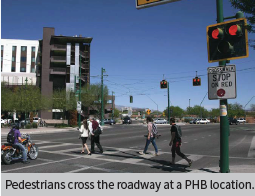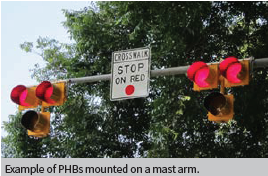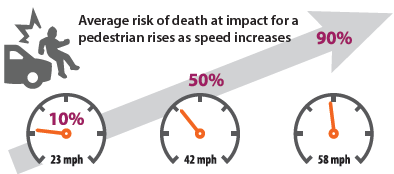U.S. Department of Transportation
Federal Highway Administration
1200 New Jersey Avenue, SE
Washington, DC 20590
202-366-4000
Safety Benefits:
55%
Reduction in pedestrian crashes
29%
Reduction in total crashes
15%
Reduction in serious injury and fatal crashes

Source: Zegeer, C., R. Srinivasan, B. Lan, D. Carter, S. Smith, C. Sundstrom, N.J. Thirsk, J. Zegeer, C. Lyon, E. Ferguson, and R. Van Houten. (2017). NCHRP Report 841: Development of Crash Modification Factors for Uncontrolled Pedestrian Crossing Treatments. Transportation Research Board, Washington, D.C.
The pedestrian hybrid beacon (PHB) is a traffic control device designed to help pedestrians safely cross busy or higher-speed roadways at midblock crossings and uncontrolled intersections. The beacon head consists of two red lenses above a single yellow lens. The lenses remain "dark" until a pedestrian desiring to cross the street pushes the call button to activate the beacon. The signal then initiates a yellow to red lighting sequence consisting of steady and flashing lights that directs motorists to slow and come to a stop. The pedestrian signal then flashes a WALK display to the pedestrian. Once the pedestrian has safely crossed, the hybrid beacon again goes dark.

More than 75 percent of pedestrian fatalities occur at non-intersection locations, and vehicle speeds are often a major contributing factor.1 As a safety strategy to address this pedestrian crash risk, the PHB is an intermediate option between a flashing beacon and a full pedestrian signal because it assigns right of way and provides positive stop control. It also allows motorists to proceed once the pedestrian has cleared their side of the travel lane, reducing vehicle delay.

Transportation agencies should refer to the Manual on Uniform Traffic Control Devices for information on the application of PHBs. In general, PHBs are typically used when gaps in traffic are not large enough or vehicle speeds are too high for pedestrians to cross safely. PHBs are not widely implemented, so agencies should consider an education and outreach effort when implementing a PHB within a community.
1 National Highway Traffic Safety Administration, Traffic Safety Facts - 2015 Data - Pedestrians. Report DOT HS 812 375, (Washington, DC: 2017).

